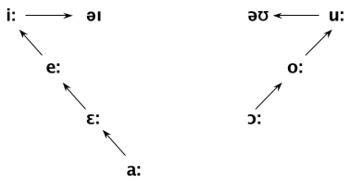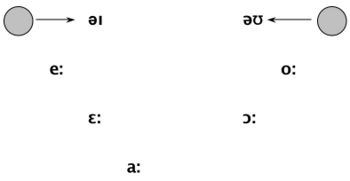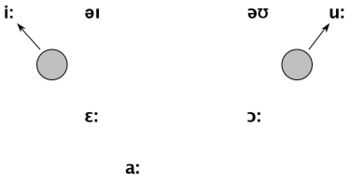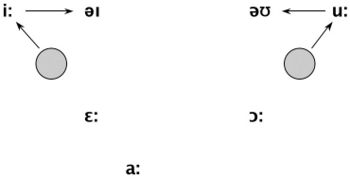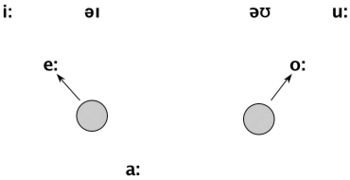Great Vowel Shift
The Great Vowel Shift (aka Tudor Vowel Shift) is a series of sound changes which affected the Middle English long vowels. The Middle English high vowels became diphthongs with low first element and all other long vowels were raised (see Fig. 1). For instance, in the word bite the initial /i:/ started to be pronounced as /əi/. The fact that nowadays the prononciation is /aʊ/ is a result of a separate development which followed the Great Vowel Shift.
The first innovating spellings reflecting the begginning of the Great Vowel Shift can be found in the East Midlands in the early fourtenth century (Lass 1999). The two top hights (/i:/, /u:/, /e:/, and /o:/) finished the raising by around 1500; the rest of the long vowels shifted later. By 1650 the Great Vowel Shift was completed.
How did the Great Vowel Shift start?
There are two major positions on the trigger of the Great Vowel Shift. For Otto Jespersen, the Great Vowel Shift was a drag chain. It started with the diphthongization of /i:/ and /u:/ to /əɪ/ and /əʊ/ respectively (Fig. 2a). At the next stage, /e:/ and /o:/ were dragged upwards to fill the empty slots left behind by the diphthongization (Fig. 2b). Finally, the remaining three long vowels /ɛ:/, /ɔ:/ and /a:/ were raised.
For Karl Luick, the Great Vowel Shift was a push chain. The trigger of the change was the raising of the mid vowels /e:/ and /o:/. On their way upwards they pushed /i:/ and /u:/ out of their slots (Fig. 3a). This changed was followed by a drag of lower vowels upwards (Fig. 3b). There is no strong textual or orthoepic evidence to reject one of the positions.
References
- Baugh, Albert C., and Thomas Cable. 1978. A History of the English Language. 3rd ed. London: Routledge & Kegan Paul.
- Diensberg, Bernhard. Linguistic Change in English: The Case of the Great Vowel Shift from the Perspective of Phonological Alternations Due to the Wholesale Borrowing of Anglo-French Loanwords. Folia-Linguistica-Historica; 1998, 19, 1-2, 103-117
- Jespersen, Otto. 1909-1949. A modern English grammar on historical principles. London: George Allen and Unwin.
- Lass, Roger. 1999. Phonology and morphology. In Roger Lass (ed.) The Cambridge History of the English Language, Vol 2: 1476-1776. Cambridge: Cambridge University Press: 56-186.
- Luick, Karl.1921-1940. Historische Grammatik der englischen Sprache. Leipzig: Tauchnitz.
- McMahon, April. 2006. Restructuring Renaissance English. In Lynda Mugglestone (ed.) The Oxford History of English. Oxford: Oxford University Press: 147-177.
- Ringe, Donald A. 2006. A History of English: Volume I: From Proto-Indo-European to Proto-Germanic. Oxford: Oxford University Press.
- Schendl, Herbert and Nikolaus Ritt. 2002. Of Vowel Shifts Great, Small, Long and Short. Language-Sciences 24, 3-4, May-July, 409-421.
- Smith, Jeremy. 1996. A Historical Study of English. London and New York: Routledge.
